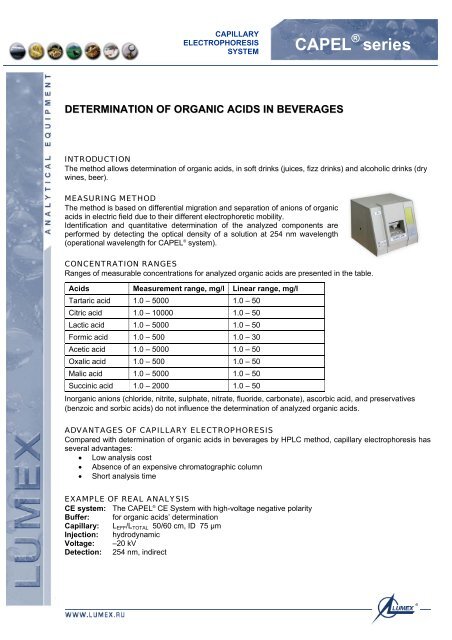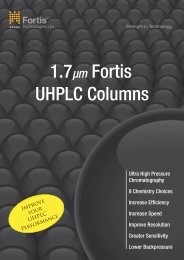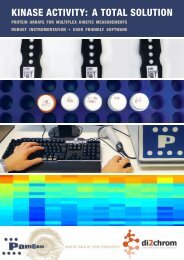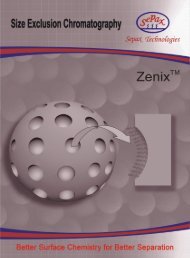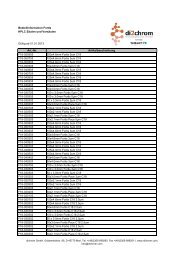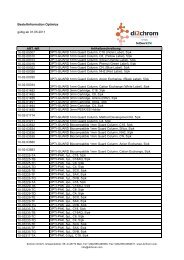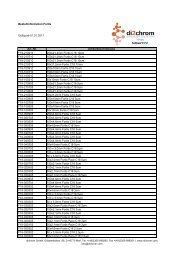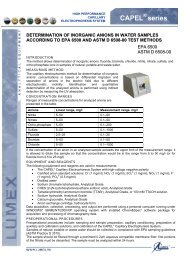Determination of organic acids in beverages - dichrom
Determination of organic acids in beverages - dichrom
Determination of organic acids in beverages - dichrom
Create successful ePaper yourself
Turn your PDF publications into a flip-book with our unique Google optimized e-Paper software.
CAPILLARY<br />
ELECTROPHORESIS<br />
SYSTEM<br />
CAPEL ® series<br />
DETERMINATION OF ORGANIC ACIDS IN BEVERAGES<br />
INTRODUCTION<br />
The method allows determ<strong>in</strong>ation <strong>of</strong> <strong>organic</strong> <strong>acids</strong>, <strong>in</strong> s<strong>of</strong>t dr<strong>in</strong>ks (juices, fizz dr<strong>in</strong>ks) and alcoholic dr<strong>in</strong>ks (dry<br />
w<strong>in</strong>es, beer).<br />
MEASURING METHOD<br />
The method is based on differential migration and separation <strong>of</strong> anions <strong>of</strong> <strong>organic</strong><br />
<strong>acids</strong> <strong>in</strong> electric field due to their different electrophoretic mobility.<br />
Identification and quantitative determ<strong>in</strong>ation <strong>of</strong> the analyzed components are<br />
performed by detect<strong>in</strong>g the optical density <strong>of</strong> a solution at 254 nm wavelength<br />
(operational wavelength for CAPEL ® system).<br />
CONCENTRATION RANGES<br />
Ranges <strong>of</strong> measurable concentrations for analyzed <strong>organic</strong> <strong>acids</strong> are presented <strong>in</strong> the table.<br />
Acids Measurement range, mg/l L<strong>in</strong>ear range, mg/l<br />
Tartaric acid 1.0 – 5000 1.0 – 50<br />
Citric acid 1.0 – 10000 1.0 – 50<br />
Lactic acid 1.0 – 5000 1.0 – 50<br />
Formic acid 1.0 – 500 1.0 – 30<br />
Acetic acid 1.0 – 5000 1.0 – 50<br />
Oxalic acid 1.0 – 500 1.0 – 50<br />
Malic acid 1.0 – 5000 1.0 – 50<br />
Succ<strong>in</strong>ic acid 1.0 – 2000 1.0 – 50<br />
In<strong>organic</strong> anions (chloride, nitrite, sulphate, nitrate, fluoride, carbonate), ascorbic acid, and preservatives<br />
(benzoic and sorbic <strong>acids</strong>) do not <strong>in</strong>fluence the determ<strong>in</strong>ation <strong>of</strong> analyzed <strong>organic</strong> <strong>acids</strong>.<br />
ADVANTAGES OF CAPILLARY ELECTROPHORESIS<br />
Compared with determ<strong>in</strong>ation <strong>of</strong> <strong>organic</strong> <strong>acids</strong> <strong>in</strong> <strong>beverages</strong> by HPLC method, capillary electrophoresis has<br />
several advantages:<br />
• Low analysis cost<br />
• Absence <strong>of</strong> an expensive chromatographic column<br />
• Short analysis time<br />
EXAMPLE OF REAL ANALYSIS<br />
CE system: The CAPEL ® CE System with high-voltage negative polarity<br />
Buffer: for <strong>organic</strong> <strong>acids</strong>’ determ<strong>in</strong>ation<br />
Capillary: L EFF /L TOTAL 50/60 cm, ID 75 µm<br />
Injection: hydrodynamic<br />
Voltage: –20 kV<br />
Detection: 254 nm, <strong>in</strong>direct
CAPILLARY<br />
ELECTROPHORESIS<br />
SYSTEM<br />
CAPEL ® series<br />
Sample: test solution <strong>of</strong> <strong>organic</strong><br />
<strong>acids</strong> and phosphate (10 mg/l <strong>of</strong><br />
each acid):<br />
1 − oxalic acid<br />
2 − formic acid<br />
3 − tartaric acid<br />
4 − malic acid<br />
5 − citric acid<br />
6 − succ<strong>in</strong>ic acid<br />
7 − lactic acid<br />
8 − phosphate<br />
9 − acetic acid<br />
10 − propionic acid<br />
3.5 mAU<br />
9<br />
6<br />
1<br />
4 10<br />
5<br />
2 3 7 8<br />
2 3 m<strong>in</strong><br />
Sample: dark beer, diluted 1:20<br />
Measurement results:<br />
1 – oxalic acid (9.8 mg/l)<br />
2 − malic acid (82.3 mg/l)<br />
3 – citric acid (148 mg/l)<br />
4 − succ<strong>in</strong>ic acid (46.2 mg/l)<br />
5 – lactic acid (67 mg/l)<br />
6 – phosphate<br />
7 − acetic acid (107 mg/l)<br />
6 mAU<br />
1<br />
2 3 4<br />
5<br />
6<br />
7<br />
2 3<br />
m<strong>in</strong><br />
Sample: dry white w<strong>in</strong>e, diluted<br />
1:50<br />
Measurement results:<br />
1 − tartaric acid (1415 mg/l)<br />
2 − malic acid (1643 mg/l)<br />
3 − citric acid (465 mg/l)<br />
4 − succ<strong>in</strong>ic acid (500 mg/l)<br />
5 − lactic acid (1165 mg/l)<br />
6 − phosphate<br />
7 − acetic acid (405 mg/l)<br />
3.5 mAU<br />
1<br />
2<br />
2 3 m<strong>in</strong><br />
3<br />
4<br />
5<br />
6<br />
7<br />
Sample: cherry juice, diluted 1:100<br />
Measurement results:<br />
1 – malic acid (2725 mg/l)<br />
2 – citric acid (3054 mg/l)<br />
3 – lactic acid (112 mg/l)<br />
4 – phosphate<br />
3.5 mAU<br />
1<br />
2<br />
3 4<br />
2 3 m<strong>in</strong><br />
The contents on this paper are subject to change without notice.


